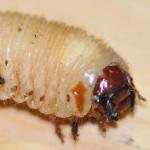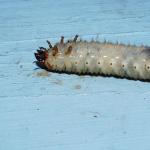ABW on the move
Annual bluegrass weevil activity is starting to pick up now, as our spring temperatures begin to warm up. Adults have moved out of their overwintering sites and have been active in the usual places for the past 10 days or so. All the plant phenological indicators that we normally use to time an insecticide to target adults are present in most parts of southern New England. Forsythia have progressed from "half green - half gold" to noticeable green, eastern red bud is in full bloom, and dogwoods have reached full bloom in many locations.
As many of you know, we receive turf samples from six golf courses for the Weevil Trak program each week. Two of those samples (from near Albany NY and Springfield MA) contained tiny larvae this week! So some of the earliest adults went ahead and got on with the business at hand, mating and reproducing. I personally believe that most of the adults are just nearing reproductive maturity and will be laying eggs soon.
So it is time to make your "adulticide" application early next week, if you have not already done so. The reason I am suggesting that you wait is that the current weather forecast is calling for more than an inch of rain falling on Friday into Saturday. Even though the kinds of products you would be using (pyrethroid or chlorpyrifos) are tightly bound to organic matter, it makes no sense to apply them when you know heavy rain is coming. So let conditions dry out a little bit and make the application early next week (the week of 8 May).
As Ben McGraw notes, one of the goals of the spring adulticide application is to eliminate a significant number of adults during the time when they are laying eggs. This functionally reduces the "window" of larvae hatching. If the emergence of larvae is somewhat synchronized, subsequent applications can be timed and targeted much more effectively.
Green June beetles!!!
My neighbor brought a coffee can of soil over to the house the other day, loaded with very large (1 to 1.5 inch long) white grubs. The neighbor had collected the grubs from the compost pile. The grubs were very healthy and were moving around on their backs. They appear to be green June beetle (Cotinus nitida) grubs. This species is common throughout the eastern United States and has been reported from southeastern New York state and Long Island, as well as southwestern Connecticut. These grubs appeared to be very comfortable in their surroundings, and it makes me think there are likely more of them getting established in Massachusetts.
They can be a pest of any kind of turf setting, including lawns, sports fields, golf courses, cemeteries, and parks.
Green June beetle (GJB) have a life cycle that is quite similar to that of other annual white grubs. Adults are active for three or four weeks in early summer, and feed on overripe fruits. The grubs are active from late July through fall, and again in the spring before pupating in June. They often come to the surface at night to feed on dead and decaying organic matter. They produce noticeable burrows as they crawl to the surface, and often leave mounds of soil (2 -3 inches in diameter) in the opening of the vertical burrow. They don't usually feed directly on turf roots, but can cause considerable mechanical damage as they knock roots and root hairs off the plant. They also can cause damage to young corn, oats, and alfalfa, especially in fields that use manure as a fertilizer.
No need to panic yet - but keep your eyes open and let us know if you see any larvae that are moving around on their backs! I am wondering how well established GJB might be in Massachusetts.
Green June Beetle Primer:
- Green June beetle larvae move about on their backs. There is a series of short stiff spines along each segment on the "backside", which helps the grub move through soil.
- Their legs are much smaller than you would expect for the size of the grub.
- There is a distinct brown sclerotized plate just a little behind the head.
- The tail end is usually a little "fatter" than the head end.
Submitted by: Dr. Pat Vittum

